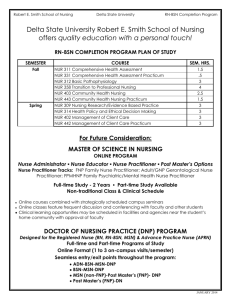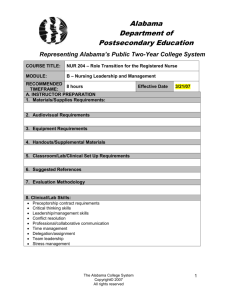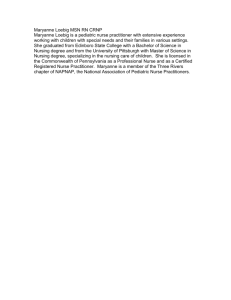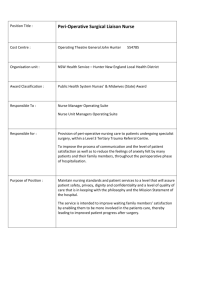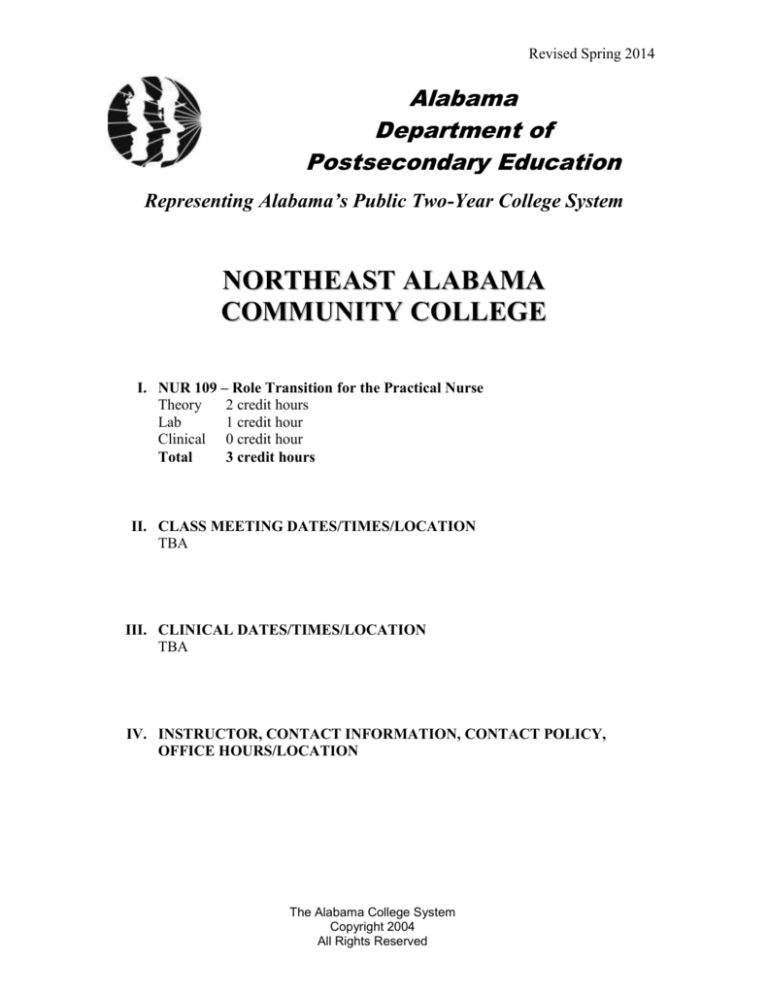
Revised Spring 2014
Alabama
Department of
Postsecondary Education
Representing Alabama’s Public Two-Year College System
NORTHEAST ALABAMA
COMMUNITY COLLEGE
I. NUR 109 – Role Transition for the Practical Nurse
Theory
2 credit hours
Lab
1 credit hour
Clinical 0 credit hour
Total
3 credit hours
II. CLASS MEETING DATES/TIMES/LOCATION
TBA
III. CLINICAL DATES/TIMES/LOCATION
TBA
IV. INSTRUCTOR, CONTACT INFORMATION, CONTACT POLICY,
OFFICE HOURS/LOCATION
The Alabama College System
Copyright 2004
All Rights Reserved
Role Transition for the Practical Nurse
NUR 109
V. COURSE DESCRIPTION:
The course provides students with opportunities to gain knowledge and skills
necessary to transition from student to practicing nurse. Content includes a
discussion of current issues in health care, practical nursing leadership and
management, professional practice issues, and transition into the workplace.
Emphasis is placed on NCLEX-PN test-taking skills, computer-assisted
simulations and practice tests, development of a prescriptive plan for remediation,
and review of selective content, specific to the practice of practical nursing.
VI. PREREQUISITE(S)/CO-REQUISITE(S)
PREREQUISITES:
NUR 102 – Fundamentals of Nursing
NUR 103 – Health Assessment
NUR 104 – Introduction to Pharmacology
MTH 116 – Mathematical Applications
NUR 105 – Adult Nursing
NUR 106 – Maternal and Child Nursing
BIO 201 – Anatomy and Physiology I
BIO 202 – Anatomy and Physiology II
ENG 101 – English Composition I
CO-REQUISITES:
NUR 107 – Adult/Child Nursing
NUR 108 – Psychosocial Nursing
VII. TEXTBOOK(S) AND OTHER LEARNING RESOURCES
See Reading Assignment
VIII. COURSE OBJECTIVES
1. Explain current issues in health care.
2. Demonstrate leadership and management skills.
3. Incorporate professional practices when managing client care.
4. Explain state board of nursing and licensure eligibility requirements.
5. Prepare for transition to the workplace.
6. Prepare for the NCLEX-PN.
The Alabama College System
Copyright 2004
All Rights Reserved
2
Role Transition for the Practical Nurse
NUR 109
IX. PROFESSIONAL COMPETENCIES
Explain current issues in health care.
Demonstrate leadership and management skills.
Incorporate professional practices into managing client care.
Explain state board of nursing and licensure eligibility requirements.
Prepare for transition to the workplace.
Prepare for the NCLEX-PN.
MODULE A – CURRENT ISSUES IN HEALTH CARE
A1.0 Explain current issues in health care.
A1.1 This module is measured cognitively.
A1.1.1
A1.1.2
A1.1.3
A1.1.4
A1.1.5
A1.1.6
A1.1.7
A1.1.8
A1.1.9
A1.1.10
Differentiate between primary, secondary, and tertiary health care
services.
Explain factors that influence health care.
Explain services provided in selected health care settings.
Explain the role of the licensed practical nurse in selected health care
settings.
Predict the effect of staffing patterns, full time equivalent, acuity,
and client classification systems on the quality of health care.
Describe the differences among financial programs for health care
service reimbursement.
Explain the role of the licensed practical nurse in quality
improvement and quality assurance.
State the importance of resource management.
Explain the response of the licensed practical nurse to current
challenges in health care.
Explain the impact of emerging technologies in health care.
MODULE B –PRACTICAL NURSING LEADERSHIP AND MANAGEMENT
B1.0 Demonstrate leadership and management skills.
B1.1 Given scenarios use leadership and management skills to resolve
selected issues in health care.
B1.1.1
B1.1.2
B1.1.3
B1.1.4
B1.1.5
B1.1.6
B1.1.7
B1.1.8
B1.1.9
Contrast the roles of registered nurse, practical nurse, and unlicensed
assistive personnel.
Differentiate between leadership and management.
Identify leadership styles.
Identify leadership skills.
Explain the roles and responsibilities of members of a team.
Explain the role of the licensed practical nurse related to professional
and collaborative communication within the health care team.
Explain the relationship between decision making and problem
solving.
Outlines the skills needed for effective management.
Explain prioritizing client care.
The Alabama College System
Copyright 2004
All Rights Reserved
3
Role Transition for the Practical Nurse
B1.1.10
B1.1.11
B1.1.12
B1.1.13
B1.1.14
B1.1.15
B1.1.16
NUR 109
Differentiate between assignment and delegation.
Explain the rights of delegation.
Explain the legal aspects of delegation according to Boards of
Nursing.
Explain time management.
Explain conflict management.
Explain stress management techniques.
Explain the role of the licensed practical nurse in client advocacy.
MODULE C – PROFESSIONAL PRACTICE ISSUES FOR PRACTICAL
NURSES
C1.0 Incorporate professional practices into managing client care.
C1.1 Given clinical situations or scenarios, intervene professionally as a
licensed practical nurse.
C1.1.1
C1.1.2
C1.1.3
C1.1.4
C1.1.5
C1.1.6
C1.1.7
C1.1.8
C1.1.9
C1.1.10
C1.1.11
C1.1.12
Explain application of laws pertaining to nursing practice.
Explain the scope of practice for licensed practical nurses according
to the Nurse Practice Act.
Identify actions to take concerning actual or suspected sexual
harassment.
Explain the impact of cultural diversity on health care.
Identify actions to take concerning workplace violence.
Explain legal and ethical issues related to end-of-life decisions.
Differentiate among advanced directives, living wills, and durable
power-of-attorney for health care (DPAHC).
Recognize breaches of client confidentiality and privacy.
Explain elements of malpractice.
Explain application of ethical principles.
Explain whistleblower protection statutes.
Explain professional behaviors and expectations of licensed practical
nursing.
MODULE D – TRANSITION TO THE WORKPLACE
D1.0 Explain state board of nursing and licensure eligibility requirements.
D1.1 This competency is measured cognitively.
D1.1.1
D1.1.2
D1.1.3
D2.0
Explain state board of nursing and licensure eligibility requirements.
Explain applying for licensure using online resources.
Explain licensure renewal.
Prepare for transition to the workplace.
D2.1 Practice effective job search techniques.
D2.1.1
D2.1.2
D2.1.3
Explain conducting a job search.
Identify elements of a job description.
Identify proper telephone etiquette.
The Alabama College System
Copyright 2004
All Rights Reserved
4
Role Transition for the Practical Nurse
D2.2
Develop required correspondence for obtaining a job in health care.
D2.2.1
D2.2.2
D2.2.3
D2.2.4
D2.3
Identify components of a resume.
Identify components of a cover letter.
Identify the process of completing a job application.
Identify components of a letter of resignation.
Role play the position of an applicant seeking a job in health care.
D2.3.1
D2.3.2
D2.4
NUR 109
Explain the process of participating in a successful job interview.
Explain proper dress and appearance for a job interview.
This competency is measured cognitively.
D2.4.1
D2.4.2
D2.4.3
Explain career mobility options for the practical nurse.
Explain pre-employment examinations and drug screening
requirements.
Explain background check requirements for employment.
MODULE E – NCLEX–PN PREPARATION
E1.0 Prepare for the NCLEX-PN.
E1.1 Take necessary actions to prepare to complete the NCLEX-PN.
E1.1.1
E1.1.2
E1.1.3
E1.1.4
E1.1.5
Explain the Computerized Adaptive Testing (CAT).
Explain the steps for preparing for the NCLEX-PN.
Identify elements of the NCLEX-PN test plan.
Explain test taking strategies.
Explain the elements of a prescriptive plan for remediation.
The Alabama College System
Copyright 2004
All Rights Reserved
5
Role Transition for the Practical Nurse
NUR 109
X. OUTLINE OF MODULES
MODULE A – CURRENT ISSUES IN HEALTH CARE
Health care delivery systems
○ Types of health care services
Primary
Secondary
Tertiary
○ Factors influencing health care
Accessibility
Cost
Quality of services
○ Health Care Settings
Ambulatory services
Inpatient care
Home health
Long-term care
Day programs
Assisted living
Hospice
Schools
Industrial clinics
Community nursing centers
Voluntary health care agencies
Rural primary care hospitals
Trends and economics in the health care delivery system
○ Role of the licensed practical nurse
○ Staffing, FTE, acuity, client classification systems
○ Managed care
Preferred Provider Organizations (PPO)
Health Maintenance Organizations (HMO)
Exclusive Provider Organizations (EPO)
○ Government Sponsored Insurance Plan
Medicare – Medicaid
Diagnostic Related Groups (DRG)
Military Health Care (Tri-care/CHAMPUS)
Children’s Health Insurance Program
Centers for Medicare and Medicaid (CMS)
○ Private Pay/Non-insured
○ Private Insurance
○ Independent practice
○ Quality improvements/quality assurance
Cost-effective practices
Quality assurance practices
Quality improvement practices
The Alabama College System
Copyright 2004
All Rights Reserved
6
Role Transition for the Practical Nurse
NUR 109
Critical pathways, care maps, nursing care plans
Resource management
Challenges for healthcare providers within the health care system
○ Disillusionment with providers
○ Loss of control
○ Decreased hospital use
○ Changing practice settings
○ Ethical issues
○ Vulnerable populations
Nursing’s response to health care challenges
○ Agenda for health care reform
○ Standards of care
○ Advanced practice
Nursing informatics
○ Computerized documentation
○ Access to information
o Privacy protection
MODULE B – PRACTICAL NURSING LEADERSHIP AND MANAGEMENT
Differentiation of practice
○ RN
○ LPN
○ Unlicensed Assistive Personnel
Leadership vs. Management
Leadership styles
Leadership skills
Team building
○ Team membership
○ Roles
○ Group dynamics
○ Professional – collaborative communication
Decision making and problem solving
Management skills
○ Planning
○ Organizing
○ Supervising
○ Monitoring
Prioritizing care
Delegation vs. assignment
○ Boards of Nursing
Administrative Code
http://www.abn.state.al.us
Chapter 610-X-2
Nurse Practice Act
The Alabama College System
Copyright 2004
All Rights Reserved
7
Role Transition for the Practical Nurse
NUR 109
o Rights of delegation
Time Management
Conflict Management
o Conflict resolution strategies
o Negotiation strategies
o Institutional policies
o Contractual and informal agreements
o Collective bargaining
Stress Management
Client Advocacy
MODULE C- PROFESSIONAL PRACTICE ISSUES FOR PRACTICAL
NURSES
Application of laws pertaining to nursing practice
Application of the Nurse Practice Act
Sexual harassment
Cultural diversity
○ Definitions and concepts
○ Influences on healthcare beliefs and practices
○ Concept of time
○ Communication
○ Social organization
Religious beliefs and practices
Family structure
Gender roles
○ Nutrition and food preferences
○ Wellness and illness beliefs and practices
○ Educational background
○ Practitioners and remedies
Violence in the workplace
Application of end-of-life decisions and the law
Advanced directives
Confidentiality and privacy
Malpractice
Ethical issues
○ Application of ethical principles
○ Euthanasia
○ Value systems
Whistle blowing
Professional behaviors and expectations
○ Membership in professional organizations
○ Community involvement
○ Representing the profession of nursing
The Alabama College System
Copyright 2004
All Rights Reserved
8
Role Transition for the Practical Nurse
NUR 109
MODULE D - TRANSITION INTO THE WORKPLACE
State board of nursing and licensure
o Scope of practice
o Continuing education
o Temporary licensure
o License renewal
Employability skills
○ Job searching
Job descriptions
Telephone skills
○ Job correspondence
Resumes and cover letters
Applications
Letters of resignation
○ Interviewing skills
○ Dress and appearance
Career mobility
○ Employment opportunities
○ Articulation
Pre-employment examinations and drug screening
Background checks
MODULE E - NCLEX–PN PREPARATION
Computerized Adaptive Testing (CAT)
Preparing for the NCLEX-PN
NCLEX-PN Test Plan
○ Categories of client needs
○ Phases of the nursing process
○ Percentages of items
Test-taking strategies
Preparation of Applications for Board of Nursing and Registration for
NCLEX-PN
Computer-assisted simulations
Practice tests
Development of a prescriptive plan for remediation
Review of content specific to practical nursing
Diagnostic NCLEX readiness examination
The Alabama College System
Copyright 2004
All Rights Reserved
9
Role Transition for the Practical Nurse
XI.
NUR 109
EVALUATION AND ASSESSMENT
Course Grade
1. The course grade is a composite grade based on the following:
a. Comprehensive Assessment Test – HESI EXIT (30%)
Students will be required to take the HESI EXIT Exam in July. If the
student does not pass the exam, he/she must participate in remediation
as prescribed by the faculty and retake the HESI EXIT Exam prior to
program completion, for an additional fee of $50.00.
b. Selected written assignments and projects (30%)
c. NCSBN NCLEX-PN (40%)
Student must achieve a grade of 75% or above in each course to continue
in the nursing program. A grade below 75% will result in a “D” or an “F”
depending on the numerical score.
2. Course and instructor evaluation by each student is required.
3. In the event of a failing grade, students are urged to see their instructor for
a conference.
XII. ATTENDANCE
Students are expected to attend all classes for which they are registered. The
student must be present 80% of the scheduled class dates in order to demonstrate
the expected course outcomes and successfully apply theoretical concepts to the
clinical practicum. Students who are unable to attend class regularly, regardless
of the reason or circumstance, should withdraw from that class before poor
attendance interferes with the student’s ability to achieve the objectives required
in the course. Withdrawal from class can affect eligibility for federal financial
aid. Withdrawal from class can prohibit progression in nursing and allied health
programs.
XIII. STATEMENT ON DISCRIMINATION/HARASSMENT
The College and the Alabama Board of Education are committed to providing
both employment and educational environments free of harassment or
discrimination related to an individual’s race, color, gender, religion, national
origin, age, or disability. Such harassment is a violation of State Board of
Education policy. Any practice or behavior that constitutes harassment is a
violation of State Board of Education policy. Any practice or behavior that
constitutes harassment or discrimination will not be tolerated.
The Alabama College System
Copyright 2004
All Rights Reserved
10
Role Transition for the Practical Nurse
NUR 109
XIV. AMERICANS WITH DISABILITIES
The Rehabilitation Act of 1973 (Section 504) and the American with Disabilities
Act of 1990 state that qualified students with disabilities who meet the essential
functions and academic requirements are entitled to reasonable accommodations.
It is the student’s responsibility to provide appropriate disability documentation to
the College. Please contact the ADA representative.
XV. COURSE CALENDAR
Course Calendar will be provided to student by the first day of class.
The Alabama College System
Copyright 2004
All Rights Reserved
11
Role Transition for the Practical Nurse
NUR 109
XVI. STUDENT ACKNOWLEDGEMENT FORM
I have received the Course Syllabus for NUR 109: Role Transition for the
Practical Nurse.
My signature indicates that I have read and understand the contents.
___________________________________________
Student’s Signature
___________________________________________
Print Name
___________________________________________
Date
The Alabama College System
Copyright 2004
All Rights Reserved
12
Role Transition for the Practical Nurse
NUR 109
Northeast Alabama Community College
Evaluation of Learning Outcomes for Career/Technical Courses
Student Learning Outcomes Form 1
Faculty regularly review the extent to which the course and program learning outcomes identified
in a course syllabus are being attained by students who complete the course. Each syllabus
identifies the assessment method that will be used to demonstrate student mastery of the desired
learning outcomes for that course. Before teaching a course, faculty should review the syllabus to
understand how the learning outcomes will be evaluated. Once the course is complete, this form
is used by the instructor to report how well students demonstrated mastery of those course
learning (and by extension, program learning) outcomes.
Course Prefix & No.: NUR 109
Instructor: Cindy Jones
Semester:
Type of Delivery – Mark One*:
Course Title: Role Transition for the PN
Date:
Section Number(s):
Dual Enrollment
Online
Traditional
*Double click on the appropriate box. When the form field menu appears, select “checked” under Default value.
Note: To insert or delete rows on the table, click on Table on the tool bar.
Learning Outcome
Evaluation Method
Evaluation Results
(Industry or Professional
Competency)
Explain how each learning outcome for this course is
assessed.
Of the students who earned a grade
of C or better for the course, what
percentage demonstrated attainment
of the stated outcomes?
Explain current issues in
health care.
On a given assignment, the student will
demonstrate knowledge of current issues in
health care by scoring at least 80%.
Demonstrate leadership
The student will demonstrate leadership and
and management skills.
management skills in the clinical setting by
scoring at least 80% on the “Evaluation of
Clinical Performance” tool.
Incorporate professional
The student will demonstrate professionalism in
practices into managing
the clinical setting according to the “Evaluation
health care.
of Clinical Performance” tool.
(Satisfactory=80%)
Explain state board of
The student will complete the NCSBN
nursing and licensure
application and Board of Nursing application for
eligibility requirements.
NCLEX-PN eligibility with 100% accuracy.
Prepare for transition to
The student will score 75% or greater on the Job
the workplace.
Search assignment (cover letter, resume, followup letter).
Prepare for the NCLEX- The student will score 850 or greater on the
PN.
HESI exit exam with a maximum of two
attempts.
Use of Evaluation Results
Explain how evaluation results will be used to improve the course.
Note: To insert or delete rows on the table, click on Table on the tool bar.
*Reviewed:
Cindy Jones
Division Director or Program Supervisor
*To be completed by Division Director or Program Supervisor Only
The Alabama College System
Copyright 2004
All Rights Reserved
13




